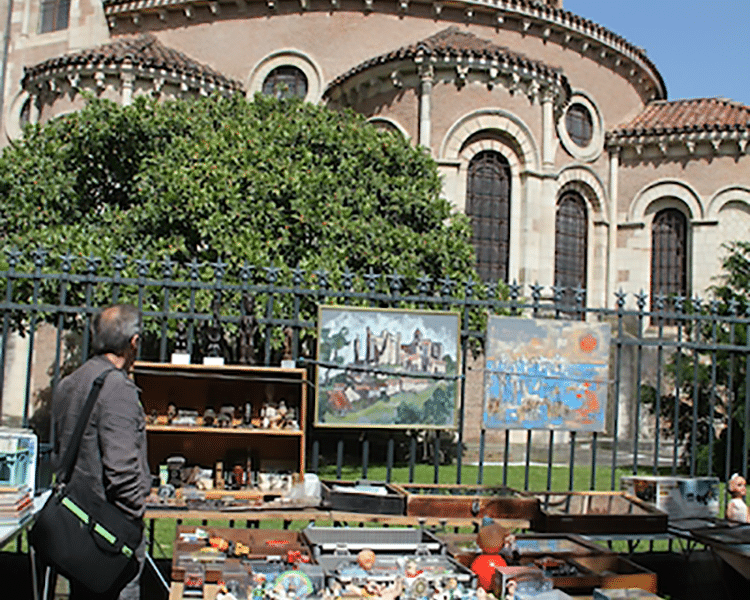The marks recording the young boy’s height etched on the walls of the medieval chateau stopped at 1 meter 52 (4 feet 9 inches). The famous post-impressionist painter, Henri de Toulouse-Lautrec, had spent summers in the chateau as a child and at age 14, after two falls resulting in broken legs which never healed properly, he stopped growing. He developed an adult sized torso, but his legs remained child sized. Unable to participate in sports, he immersed himself in art. This year marks the 150th anniversary of the birth of the artist whose cabaret posters have become synonymous with Paris and Montmartre, the neighborhood famous for its bohemian lifestyle and the haunt of artists, writers, and philosophers in the late 1800s.
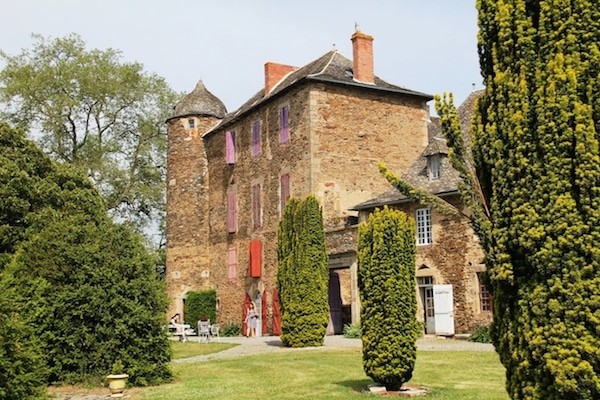
During a tour of Chateau du Bosc in the Midi-Pyrénées region of southwestern France, I learned much more about Lautrec. Nicole-Berangere Tapie de Celeyran, 89, a distant cousin of the artist, loves guiding visitors through her home. Tiny, frail, and slightly hunchbacked, she charges up the long staircases with the vitality of a teenager. I followed her from the kitchen where she pointed out Lautrec’s sketches on the wall, upstairs to a lavish salon and dining room, a bedroom, hallways, and then into the garden. “I love to talk. I want to preserve this house, the spirit of the family,” she says. She also wants to show Lautrec mementoes and correct misconceptions about the legendary artist.
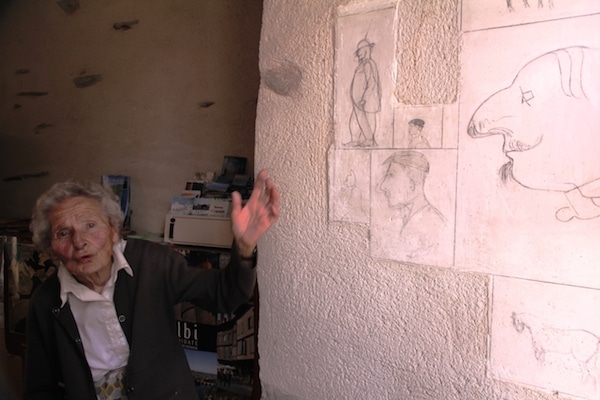
She embellishes the tour with stories passed on from her grandmother and other ancestors who knew the artist. Lautrec’s father and uncles often went hunting. They’d come back after an outing and relate tales of their adventures. Lautrec would sit on the floor and use the coal from the fireplace to make drawings of their exploits, she said. In his bedroom, the floor scattered with toys, she points out a boat Lautrec had made after one of his accidents.
It was all fascinating, especially as told by this delightful and amazing woman, and perfect background for a visit to the Toulouse-Lautrec Museum in the nearby town, Albi, where Lautrec was born in 1864. He became an alcoholic and died at the age of 37 due to complications of alcoholism and syphilis. More than 1,000 of his works – paintings, lithographs, drawings and the famous posters — are on display in the museum which has the largest collection of his works in the world. “What is important in a painting is the person. Landscape is secondary. That was his philosophy,” a museum guide recounts. He painted psychological portraits and he understood advertising, hence the posters, she continues.
Albi, perched on the banks of the Tarn River spanned by an ancient bridge, is a UNESCO World Heritage site and the spires of its mighty cathedral dominate the skyline. It almost seems too picture-perfect. The cathedral, Sainte Cécile, is the only one in France that is still in its original condition, the 15th century painted walls still visible today. During the Middle Ages, churches were painted although the paint on most has long since vanished. It has survived here because the cathedral is very dark.
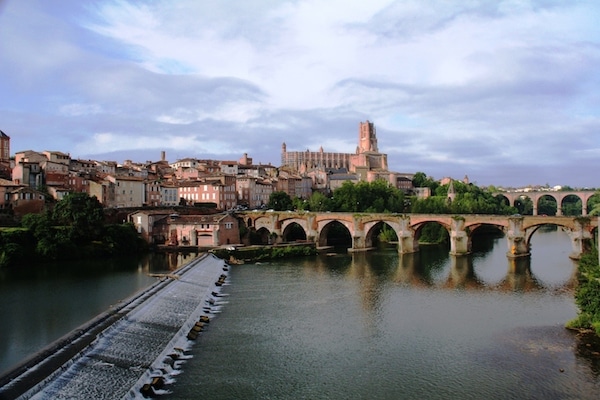
Another curious if not incredible attraction is Albi’s Museum of Miniatures. It houses 55 miniature rooms all made by a 79-year-old woman who started the project 40 years ago. As a child she wanted a dollhouse, but she never got one. So, at the age of 39 she set out to make her own, room by room. The museum curator told us that it takes her from six months to a year to make one room. She is now busy making a miniature church.
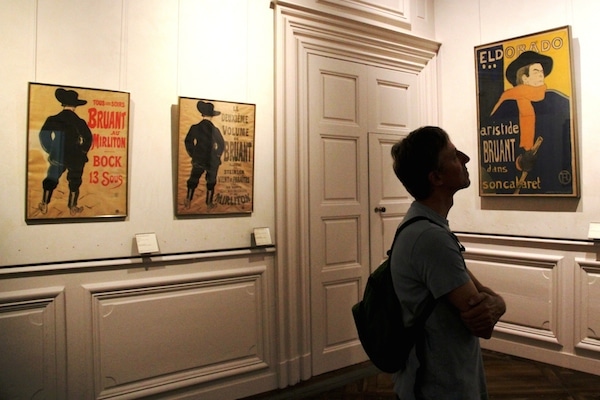
Albi and its sights were just one of many places I visited recently while exploring the Midi-Pyrénées region along with Toulouse, Rodez and Conques. The latter was my favorite and it’s easy to understand why it was named one of the “plus beaux villages de France,” (most beautiful villages in France). The tiny burg of half-timbered houses and Romanesque fountains is nestled in a valley surrounded by green. Its Romanesque Abbey Church is magnificent – and quite an experience. Every evening at 9:30 p.m. during the summer, Jean Daniel, a Benedictine monk, pounds away on a powerful organ while visitors walk around the upper galleries of the immense structure. Spotlights grow dim and then brighter, highlighting the 250 sculpted capitals atop the gallery columns. Shadows move. The sounds are not somber church music, in fact, nothing like it. During my visit The House of the Rising Sun was the monk’s selection and it made for a sound and light show like no other.
The church’s roots go back to the eighth century when a Benedictine monastery was established at the site in the wilderness. Relics were needed to give the new monastery clout. In the ninth century one monk set off to Agen and came back with part of the skull of Saint Foy, a Christian who had been martyred in the town in 303 A.D. Miracles were soon attributed to the relic, and Conques became a pilgrimage site, a holy place to visit on the road to Santiago de Compostela, the well-known pilgrimage destination in northwestern Spain where the remains of St. James are said to be buried.
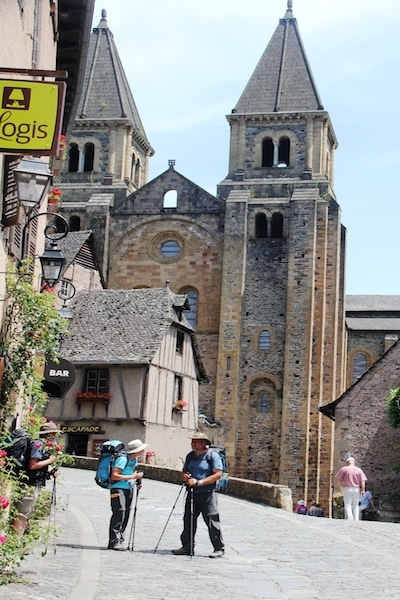
Every year about 13,000 pilgrims make the visit to Conques, a town with just 90 year-round residents. Most visit the treasury as well as the church. Lavish, bejeweled gold and silver reliquaries are displayed in glass cases. The most elaborate is said to enclose the foreskin of Christ. “How do you know it’s the foreskin of Christ?” asked a doubting visitor. “I don’t know. I was not present at the circumcision,” quipped the guide.
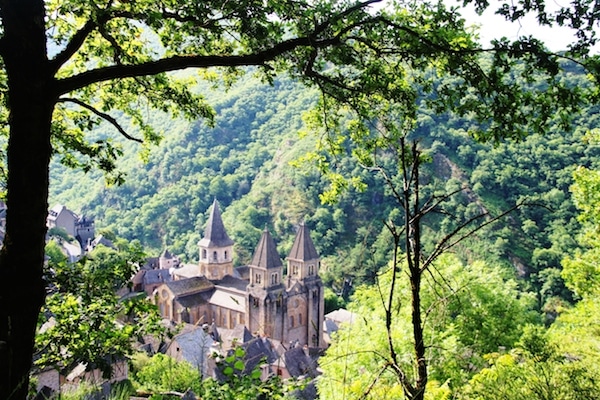
The Conques Abbey Church has another attraction – windows designed by the French contemporary artist Pierre Soulages. These bear no resemblance to the usual stained glass windows found in most churches, but were designed to let light penetrate the grandiose yet somber structure. The Soulages windows, made up of geometric shapes of glass of varying density, change color depending on the exterior light. Soulages was born in 1919 in Rodez, a Midi- Pyrénées town now a must for contemporary art fans. In May, the Soulages Museum opened with some 500 works of the renowned abstract artist who is known for his devotion to the color black.
Toulouse, France’s fourth largest city known as the European capital of aeronautics and the home of Airbus, is the capital of the Midi-Pyrénées region. This university city which is often called the “ville rose” (pink city) due to the bricks produced here and used in the construction of many of its buildings, is vibrant and attractive with magnificent churches, lively markets and excellent restaurants. Saint Sernin Basilica, the largest complex of Romanesque buildings in the world, is listed as a UNESCO World Heritage site because it was a major stop en route to Santiago de Compostela. The Jacobin Monastery, stark on the outside, is a marvel inside with famous and unique palm tree arches. Another World Heritage site is the Canal du Midi which flows through Toulouse connecting the Atlantic Ocean to the Mediterranean. The city on the banks of the Garonne River has several noted museums, including the Augustins, a fine arts museum with sculptures and paintings by famous names of the art world, including Rubens, Delacroix and Corot. Those who prefer airplanes to art will want to tour the Airbus plant facilities where the world’s largest airplane is now under construction. Tours of two different Concordes are also available.
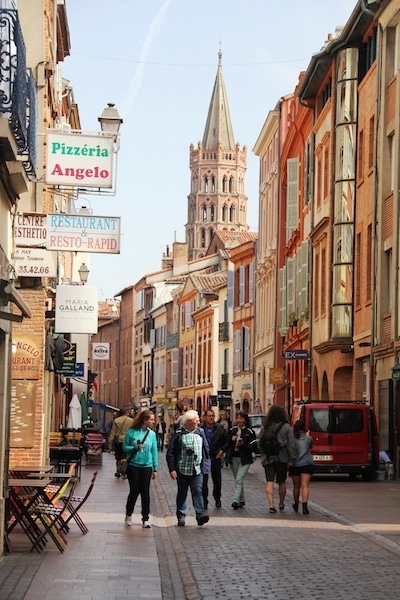
Foie gras, the fattened liver of force fed geese and ducks, may be controversial, but it’s an exquisite treat and the star of the cuisine of southwestern France. It’s found on many restaurant menus in Toulouse, as well as throughout the Midi- Pyrénées. Toulouse is best known for its sausage and the regional dish, cassoulet, a hearty stew of meats and beans. Among its wonderful restaurants are several which have earned coveted Michelin stars. The town has several markets, all fun for foodies.
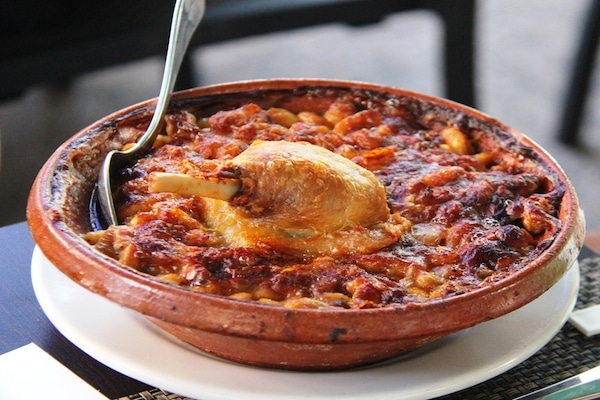
The area code for France is 33.
Where to Stay:
Hotel Mercure Albi Bastides – The banks of the Tarn is the perfect location for admiring – and photographing – Albi. This hotel, classified as a historic monument, was previously a water mill. Its riverside terrace is ideal for outdoor dining. Moulins Albigeois, 41 rue Porta, 8100 Albi; + 33 (0) 5 63 47 66 66; www.mercure.com/Albi
The Hotel Restaurant Hervé Busset – Located in a wooded setting on the banks of the lively Dourdou River just outside Conques, and a true delight. An old mill was transformed into an inn with a lovely riverside terrace for relaxing and/or dining. The interior contemporary décor is a perfect complement to the old schist stone. And, the food is fabulous. Busset has earned one Michelin star with his cuisine which makes use of plants and flowers from his garden. Domaine de Cambelong, 12320 Conques; +33 (0)5 65 72 83 91; www.moulindecambelong.com
Hotel Mercure Rodez Cathedral – The center of town offers the perfect location for visiting Rodez, the cathedral and the Soulages museum. The walls of the bar are decorated with scenes of Venice painted by Maurice Bompard. 1 avenue Victor Hugo, 12000 Rodez; +33 (0)5 65 68 55 19; www.mercure.com/Rodez
Location, Location, Location – Toulouse’s Grand Hotel de l’Opera can’t be beat. Facing the heart of the town, the Place du Capitole, the charming boutique hotel is located in a former convent of the 17th century. The luxurious rooms are decorated in red Opera or yellow sun. 1 Place du Capitole, 31000 Toulouse; +33 (0) 61 21 82 66; www.grand-hotel-opera.com/uk
Where to Eat:
Le Clos Sainte Cécile – For a delightful meal under ancient plane trees, this is the right place. The restaurant in a former school is fifth generation family owned. 3 Rue du Castelviel, 81000 Albi; + 33 (0)5 63 38 19 74
Café Bras – Located in Rodez’s Soulages Museum, it features cuisine by the noted chef, Michel Bras, who has earned three Michelin stars with his other restaurants. Both fine dining and bistro style food are available, with a lunch special for museum visitors. Musée Soulages, Jardin du Foirail, Avenue Victor Hugo, 12000 Rodez; +33 (0)5 65 68 06 70; www.cafebras.fr
Michel Sarran – In Toulouse, the noted chef Michel Sarran has earned two Michelin stars with his eponymous restaurant. The first floor dining room features chic and elegant modern décor. The tasting menu is amazing, many savory, labor-intensive delicacies served in small portions – each worthy of a photograph. 21 Boulevard Armand Duportal, 31000 Toulouse; +33 (0)5 61 12 32 32; www.michel-sarran.com
Emile – At this restaurant in Toulouse, Chef Christophe Fazan specializes in both local and creative cuisine. Located on the bustling Place Saint George, it’s a Toulouse favorite. 13 Place Saint Georges, 31000 Toulouse; +333 (0)5 61 21 05 56; www.restaurant-emile.com
What to See and Do:
Chateau du Bosc – Located in Naucelle, 30 minutes by car from Albi. Madame Tapie de Celeyran gives guided tours in French. English speaking tour guides who know all about Lautrec are also available. Tours are given year round from 10 a.m. until 7 p.m. If you visit, you’re sure to meet Madame who loves to welcome visitors. + 33 (0) 5 65 69 20 83
Museum Toulouse-Lautrec – Palais de la Berbie, Albi ; +33 (0)5 63 49 48 70 ; www.musee-toulouse-lautrec.com
Museum of Miniatures – 16 Rue Rinaldi, Albi; +33 (0)5 63 79 00 98; www.academiedesminiatures.fr
Soulages Museum – Jardin du Foirail, Avenue Victor Hugo, Rodez ; +33 (0)5 65 73 82 60; www.musee-soulages.grand-rodez.com
La Cité de l’espace – Explore the secrets of the universe and outer space in this unique park with a giant screen IMAX movie theater, planetarium, simulators, space crafts and children’s entertainment. Parc de la Plaine, Avenue Jean Gonord, Toulouse; +33 (0)5 67 22 23 24; www.cite-espace.com
Airbus, Village Aéroconstellation – Take a day trip from Toulouse to visit. Three itineraries are offered: Tour of the Airbus 380 assembly plant, bus trip to Airbus sites and/or an environment focused tour. Rue Franz-Joseph-Strauss, 31700 Blagnac; +33 (0)5 34 39 42 00; www.manatour.fr

